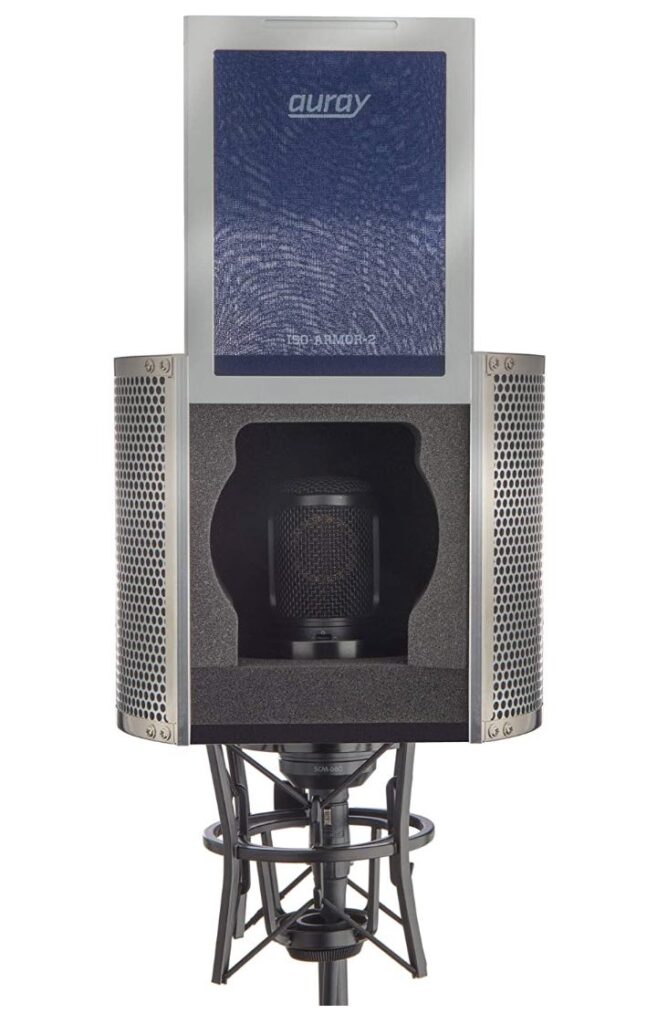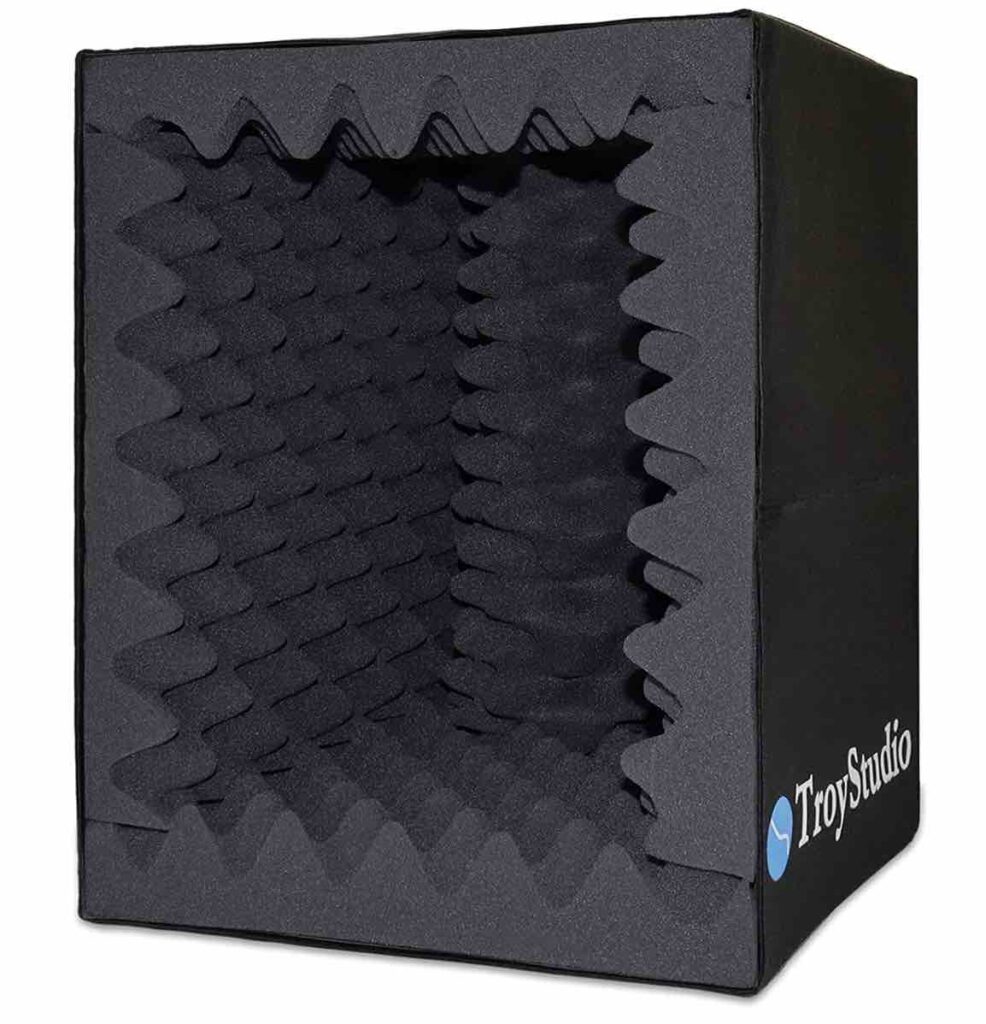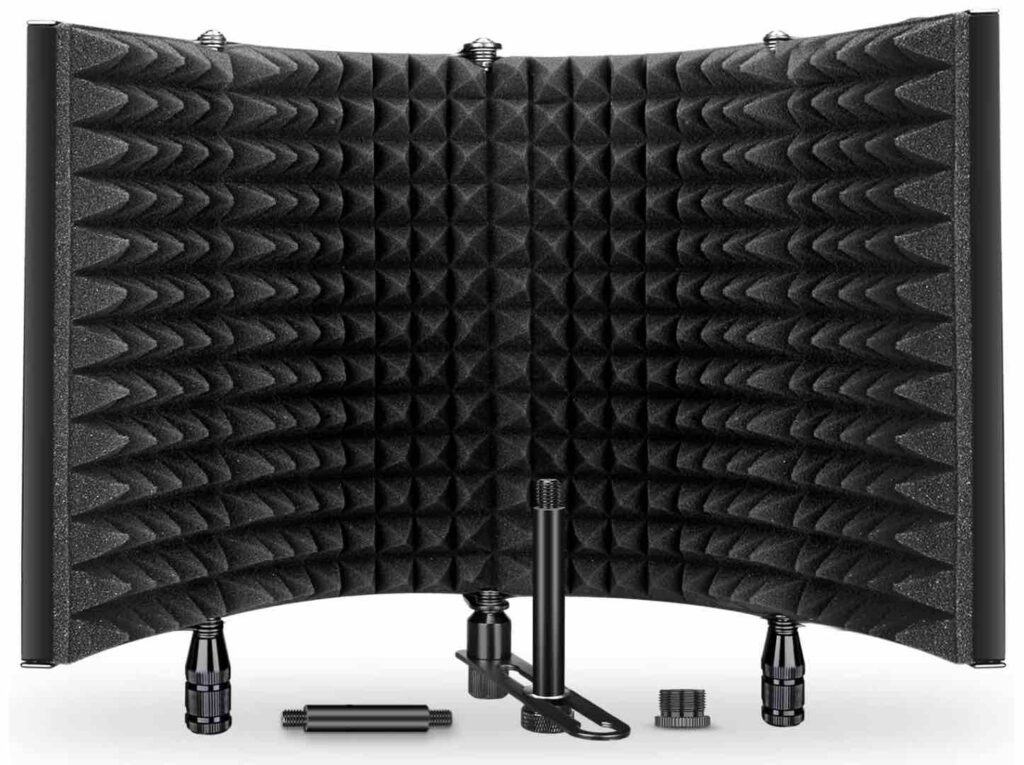Are you interested in the Koatica Eyeball?
Well, it’ll run you about $200. Is it worth that much?
We think so, but luckily there are some excellent Koatica Eyeball alternatives for a fraction of the price.
Here are three of our favorites.
Overview
Top 3 Kaotica Eyeball Alternatives
1. Auray Iso-Armor-2 Microphone Isolation Chamber

The Auray ISO-ARMOR-2 is a lightweight (1.4 lbs) microphone isolation chamber that reduces unwanted room noise and reflections.
It’s similar to the Kaotica Eyeball, except it has an aluminum outer shell to provide extra durability and isolation.
Auray uses a wide mic chamber to provide excellent isolation while maintaining natural, unobstructed sound quality.
The chamber consists of high-density acoustic foam and a built-in sliding (double-layer) pop filter.
It also comes with a mounting adapter (on the bottom) to help isolate your mic from external vibrations.
Pros
- Super-Lightweight
- Aluminum shell for durability and extra isolation
- Built-in pop filter
- Includes mounting adapter and shock mount
- Effective Kaotica Eyeball alternative for a fraction of the price
Cons
- Relatively expensive compared to the other options on this list
How to Set Up the Iso-Armor-2
The Iso-Armor-2 can fit mics with diameters up to 2.3 inches.
To set it up, you can place your mic in the chamber through the front.
If it doesn’t fit, remove the mounting adapter on the bottom. Place your mic in the mounting adapter and reattach the adapter to the chamber.
From there, you can attach a shock mount to a mic stand.
Run your mic cable through the shock mount and attach it to your mic.
Some mics will fit in a shock mount while in the chamber, but if it doesn’t, you can simply rest the chamber on the shock mount (with the mic cable attached), and it won’t fall off.
2. TroyStudio Vocal Booth Box

TroyStudio’s Vocal Booth Box is exactly what it sounds like – a 12″ (L) X 12″ (W) X 16″ (H) rectangular box (with a front opening) made entirely out of high-density acoustic foam.
It reduces unwanted reflections to provide a clean, focused recording environment in a non-acoustically treated room.
Setting up the Vocal Booth Box
The Vocal Booth Box is compatible with almost all mic stands but is also tall enough to fit a desk stand.
You can place the Booth Box on your desk with the desk stand inside. Or you can use the hole at the bottom (and mounting hardware included) to attach a mic stand (or boom arm) to your mic.
Pros
- Inexpensive
- Foldable/portable
- Tall enough to fit a desk stand
- Mounting hardware included
Cons
- Not as effective as an isolation chamber
Improving Sound Quality with the Booth Box
Since the Booth Box has a wide opening in the front, it’s less effective than a fully enclosed isolation chamber. But it’s a great affordable alternative.
Some measures you can take to improve your sound quality with the Booth Box are to place a blanket, acoustic curtain, or mattress behind your recording area.
These materials will absorb unwanted vocal reflections and prevent them from entering your mic.
3. Aokeo (AO-504) Microphone Isolation Shield

The Aokeo isolation shield features a sturdy 16″ (L) X 10″ (H) metal frame that reflects background noise and absorbs vibrations – preventing them from interfering with your recordings.
The inner layer of acoustic foam helps reduce sound reflections, giving you cleaner and more professional-sounding recordings.
Pros
- Affordable
- Foldable/portable
- Steel outer frame to reduce room noise
- Easily adjustable
Cons
- Small
- Not as effective as an isolation chamber
How to Set up the Aokeo Isolation Shield
The shield is very easy to set up.
It has an easy-to-install connecting rod that attaches to its base. At the other end of the connecting rod is a 3/8 to 5/8 adapter compatible with all mics and shock mounts.
The shield has three legs on the bottom, allowing it to stand up on a desktop.
Plus, it’s versatile.
You can move the connecting rod back and forth and adjust its height to get your mic in the desired position.
The entire shield is also foldable for easy storage and transportation.
Are Microphone Isolation Shields Worth it?
We believe isolation shields are worth it.
They reduce ambient noise from your recording environment resulting in cleaner, more focused recordings.
Isolation shields are also relatively inexpensive (compared to acoustic treatment), and they’re easy to set up and use. Plus, they’re the perfect mobile recording solution.
Do Mic Reflection Shields Work?
Yes, mic reflection shields/booths work and are highly effective.
While they won’t eliminate all reflections or noise, they can significantly reduce them, resulting in cleaner recordings.
Why are Mic Shields/Booths So Effective?
Mic shields and booths are cost-effective solutions for adding acoustic treatment directly around your microphone.
Sound reflections can bounce off nearby surfaces and make their way into your recordings.
Mic reflection shields and booths use acoustic foam to diffuse and absorb sound waves to minimize these reflections.
They also create a physical barrier between your mic and the room to reject outside noise.
By placing a shield or booth around your mic, you can create an isolated recording environment, ensuring your recordings sound more focused.
Are Isolation Shields/Booths as Effective as Acoustic Panels?
The real question is, can an isolation shield help produce the same quality you’ll get in an acoustically treated home studio?
And the answer to that question is no.
However, a shield/isolation booth is the most cost-effective acoustic treatment.
In other words, you can achieve similar audio quality with a hundred-dollar isolation booth/shield as you can with hundreds of dollars worth of acoustic panels.
Summary: Kaotica Eyeball Alternatives
Are the options on this list better than the Kaotica Eyeball?
No, but I didn’t notice much difference between the $100 Auray ISO-ARMOR-2 Microphone Isolation Chamber and the $200 Eyeball.
The TroyStudio Vocal Booth Box and the Aokeo (AO-302) Isolation Shield do a fantastic job at improving sound quality for just $32 and $28, respectively.
However, the most cost-effective solution is the Auray ISO-ARMOR-2.








